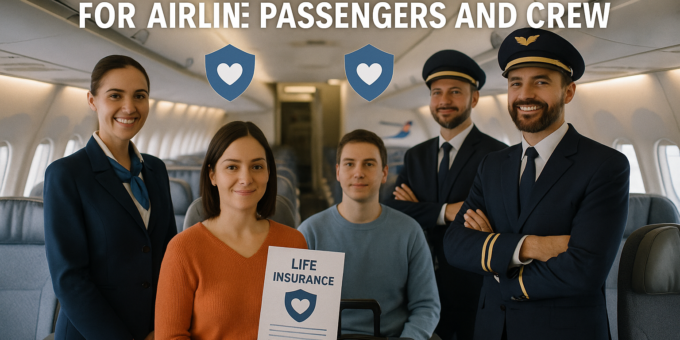
Airline travel isn’t your average journey—it’s a calculated venture into the skies where variables like weather, mechanical integrity, and human precision dance in harmony. Insurance companies understand this, and so do regulators. Therefore, insurance premiums and policy conditions shift dramatically when aviation enters the picture.
Airline crew members endure conditions that aren’t present in typical jobs: cabin pressure fluctuations, radiation exposure from frequent flights, sleep disturbances due to jet lag, and the ever-present threat of aviation incidents. These occupational hazards increase their insurance risk class.
Passengers, although at risk for shorter durations, face unique concerns, especially during takeoff, turbulence, and landing. Depending on the flight’s nature (domestic vs international), some passengers are covered by mandatory travel insurance—often bundled with ticket purchases or credit card perks. However, these are often limited in scope and do not replace proper life insurance.
Who Needs Life Insurance in Aviation?
Everyone who flies regularly—crew or passenger—should consider some form of life insurance.
-
Pilots: Especially those flying commercial or cargo planes, are categorized in higher-risk occupational brackets by insurers.
-
Flight attendants: Equally exposed to onboard emergencies and hazards.
-
Ground crew members: Though not always airborne, they also need protection due to high-risk airport environments.
-
Frequent flyers or business travelers: Regular exposure to air travel increases overall risk.
-
International travelers: Flying to unstable regions may require extra coverage due to geopolitical issues.
Insurance isn’t just about death benefits. It’s about securing your family’s financial future against unexpected events, regardless of whether you’re in uniform or carrying a passport.
Types of Life Insurance for Airline Crew Members
Aviation professionals must often combine multiple types of insurance for complete protection. Here’s a breakdown:
| Type of Insurance | Best For | Key Features |
|---|---|---|
| Term Life Insurance | Active-duty pilots & crew | Affordable, temporary coverage |
| Whole Life Insurance | Crew with long-term planning goals | Lifelong coverage with cash value |
| AD&D Insurance | Mandatory or employer-offered for crew | Pays out on accidental death or serious injury |
| Supplemental Life | Crew with families or dependents | Adds coverage beyond group policy |
| Disability Insurance | Pilots who may lose licenses | Offers income if grounded due to health conditions |
Each comes with trade-offs. For example, whole life policies cost more upfront, but they offer guaranteed benefits and investment value—ideal for career airline professionals.
Term Life Insurance Explained for Pilots and Flight Attendants
Term life insurance is a straightforward solution for many airline workers. It covers a set term—say 10, 20, or 30 years—and pays a benefit if the policyholder passes away within that time.
Why it works for airline staff:
-
Lower premiums than whole life policies
-
Flexible terms that align with career length
-
Options to convert to permanent life later
However, if the term ends and the policy isn’t renewed or converted, there is no payout. That can be a major drawback for older crew members nearing retirement.
Whole Life Insurance Options for Airline Workers
Whole life insurance offers guaranteed benefits, but with higher costs. It’s ideal for those who want long-term financial security for their loved ones or plan to use the policy as an investment.
Advantages include:
-
Fixed premiums
-
Guaranteed cash value accumulation
-
Lifelong coverage regardless of health changes
Pilots close to retirement or those who want to lock in premiums while they’re young and healthy may find this attractive, despite the initial cost.
Accidental Death and Dismemberment (AD&D) Insurance for Aviation Professionals
AD&D insurance specifically covers injuries or fatalities resulting from accidents, which are statistically more relevant in aviation roles.
Common AD&D coverage for flight crew includes:
-
Death due to plane crash or mid-air incident
-
Loss of limbs, sight, or mobility due to accident
-
Double indemnity clauses for air-related fatalities
Many airlines offer AD&D policies as part of their employment packages, but the coverage may be limited, making supplemental personal AD&D essential.
Do Airlines Provide Group Life Insurance?
Yes—but read the fine print.
Group life policies are offered to most airline employees, but they come with restrictions:
-
Often only 1x or 2x the base salary
-
Usually ends with employment
-
May not include AD&D or long-term disability
Relying solely on your employer’s plan is risky, especially if you change jobs or are temporarily grounded. Purchasing an individual plan offers portability and control.
What Life Insurance Policies Cover for Passengers
Most commercial flights are backed by:
-
Passenger Liability Insurance (mandated by aviation laws)
-
Airline-provided accidental death coverage
-
Travel insurance perks (from ticketing agencies or credit cards)
But these policies are narrow in scope. They usually cover accidental death during the flight—not pre-boarding, layovers, or ground transport.
For frequent travelers, purchasing a standalone travel life insurance policy ensures full protection across all stages of a journey.
Does Your Plane Ticket Come with Life Insurance?
Surprisingly, sometimes yes.
Some credit card companies and airlines provide limited accidental death coverage when booking flights using their services. For instance:
-
American Express and Chase Sapphire cards often include AD&D coverage.
-
International airlines may provide automatic coverage (mandated in some countries).
Caution: This insurance is conditional and often only applies when the ticket is bought using a specific method (credit card, direct airline site, etc.).
Key Differences in Crew vs Passenger Coverage
| Category | Airline Crew | Passengers |
|---|---|---|
| Coverage Source | Employer group plans & personal policies | Airline’s liability coverage or travel insurance |
| Risk Classification | High-risk occupation | General public risk class |
| Duration of Risk | Ongoing | Per flight basis |
| Medical Screening | Often required | Rarely required |
This disparity reinforces why airline crew must proactively secure adequate and permanent coverage beyond employer policies.
Government Regulations and Airline Insurance Mandates
Globally, aviation insurance is governed by:
-
ICAO (International Civil Aviation Organization) standards
-
FAA (Federal Aviation Administration) regulations
-
Warsaw Convention and Montreal Convention (for passengers)
These mandates enforce minimum coverage levels but don’t replace personal life insurance. They only ensure that victims’ families receive compensation in event of accidents—up to statutory limits.
You Can Also Read : Do You Need Life Insurance for Air Travel? A Complete Guide
The Role of Unions in Airline Crew Insurance Benefits
Unions such as the Air Line Pilots Association (ALPA) or Association of Flight Attendants (AFA-CWA) negotiate collective insurance benefits.
Benefits include:
-
Better base coverage than non-unionized staff
-
Access to supplemental group plans
-
Legal support for denied claims
Still, union-negotiated insurance should be seen as a base layer—not the whole cake.
